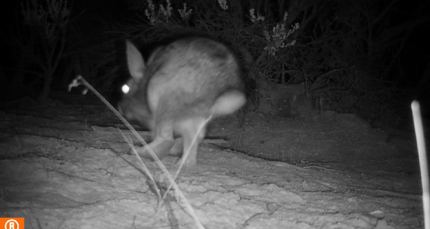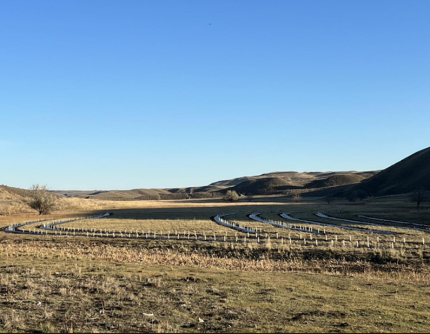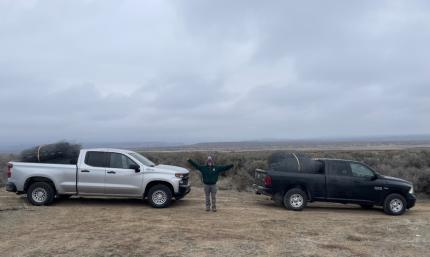Managing Wildlife Populations
Deer Management: Biologists Dougherty and Clements have completed their aerial surveys for Game Management Unit (GMU) 290 and are now gearing up to conduct additional aerial surveys along areas of the Columbia Plateau. Biologists surveyed 40 units in GMU 290 and observed over 380 deer across the units.

Annual Deer Surveys: Private Lands Biologist Braaten assisted District 7 staff members with annual deer surveys in Douglas County. Private Lands Biologist classified 149 mule deer (95 does, 31 fawns, and 23 bucks). Biologist Morris conducted deer ground surveys in Adams and Grant counties to classify deer by age and sex. The district biologist will use these surveys to develop hunting recommendations for future hunting seasons in the area.



Pygmy Rabbit Drone Surveys: The team continues to test the best drone survey method for pygmy rabbit burrows. Adjusting the height and speed of the drone makes a great impact on the clarity of the images. Other considerations include image overlap, camera angle, wind speed, and weather conditions.

Rimrock Wild Population Pygmy Rabbit Monitoring: For the last two weeks, the Passive Integrated Transponders (PIT) monitoring system has been moved around the Rimrock Meadows wild population area. The array was set up between active burrow systems in hopes of obtaining individual identifications. Much to the dismay of the biologists, no rabbits were detected via the PIT tag monitoring system. Cameras were set up in the vicinity the system to observe if there were pygmy rabbits in the area that were simply un-tagged. The cameras showed only cottontails, confirming that the PIT tag monitoring system was functioning and had not missed any pygmy rabbits.

Pygmy Rabbit Rimrock Breeding Enclosure: The raptor netting was completely extracted from the Rimrock enclosure before winter conditions hit the region. These large 8-foot by 30-foot nets were deployed within the enclosure to provide extra protection from raptors, including hawks and owls. In times without snow, these nets are perfectly safe for rabbits. However, in extreme snowfall these nets could collapse onto the ground and potentially entangle a rabbit.


Conserving Natural Landscapes
Native Tree and Shrub Planting: Private Lands Biologist Braaten and Region 2 Private Lands staff members, landowners, and volunteers worked to complete a Private Lands Riparian Habitat Project in Douglas County. The landowner was awarded Natural Resource Conservation Service awards with technical and financial assistance from their Environmental Quality Incentives Program. The landowner had a long working relationship with Washington Department of Fish and Wildlife (WDFW) over many years. He reached out for assistance and WDFW Private Lands staff members assisted to complete the project in three days. Two thousand trees and shrubs were planted in mulch fabric.
Habitat Plots: Biologist Morris sprayed weeds in a habitat plot so that hopefully next year the weeds will be controlled, and he will be able to continue planting native shrubs, grasses, and forbs to benefit wildlife.




Fall Riparian Habitat Planting: Private Lands Biologist Braaten was able to get some more fall hand planting done in Douglas County before snow and freezing temperatures returned. Sixty red osier dogwoods, 30 elderberry, and 20 service berries were planted.


Pygmy Rabbits Release Pen Removal: The 2022 Palisade release pens have been removed from the field and are back in storage until release efforts resume. Even with near frozen ground, the Washington Conservation Corp, based out of Wenatchee, did an excellent job prying these fences out and rolling them up for removal.

Conducting Business Operations and Policy
Columbia Basin Pygmy Rabbit Working Group: The first Columbian Basin Pygmy Rabbit Working Group meeting, hosted and led by Biologist Husband of the U.S. Fish and Wildlife Service, took place on Nov. 28. This group brings multiple partners together for the recovery of the Columbian Basin pygmy rabbit. While not a decision-making body, this provides a working space for brainstorming and sharing ideas regarding the recovery of the Columbian Basin pygmy rabbit. Twenty-nine people from seven different agencies attended.